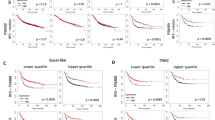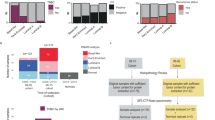Abstract
It is now clearly established that proteolytic enzymes, including plasminogen activator (uPA), play an important role in breaking down the extracellular matrix, which is considered to be a step in metastasis formation. Plasminogen activators are controlled at various levels. Two inhibitors, PAI-1 and PAI-2, have been identified, the latter being more specific for uPA. In attempts to determine their prognostic value, it is essential to investigate the relative importance of these parameters and their interactions. We used an immunoenzymatic method to assay uPA, PAI-1 and PAI-2 antigens in cytosols prepared from 314 primary breast tumours. The patients were followed up for a minimum of 6 years and all relevant clinical and laboratory findings were recorded. Univariate analysis confirmed the poor outcome of patients whose tumours contained large amounts of uPA and PAI-1. In addition, low levels of PAI-2 correlated with shorter disease-free survival in the overall population (P = 0.02), post-menopausal women (P = 0.02) and women without lymph node involvement (P = 0.02). Multivariate analysis in the 'main effects' Cox model identified node involvement, macroscopic tumour size and PAI-2 as significant variables. The 'interactive' model, taking into account interactions between uPA and its two inhibitors, identified a first subgroup with a very poor prognosis associating either high levels of PAI-1 with low levels of PAI-2 in the overall population and the women with no node involvement or high levels of uPA with low levels of PAI-2 in the group of menopausal women. We conclude that PAI-1 provides the same prognostic information as uPA, and does not appear to play a role as an inhibitor. In contrast, PAI-2 increases the prognostic value of uPA, particularly in post-menopausal women, and PAI-1 in patients with no node involvement.
This is a preview of subscription content, access via your institution
Access options
Subscribe to this journal
Receive 24 print issues and online access
$259.00 per year
only $10.79 per issue
Buy this article
- Purchase on Springer Link
- Instant access to full article PDF
Prices may be subject to local taxes which are calculated during checkout
Similar content being viewed by others
Author information
Authors and Affiliations
Rights and permissions
About this article
Cite this article
Bouchet, C., Spyratos, F., Martin, P. et al. Prognostic value of urokinase-type plasminogen activator (uPA) and plasminogen activator inhibitors PAI-1 and PAI-2 in breast carcinomas. Br J Cancer 69, 398–405 (1994). https://doi.org/10.1038/bjc.1994.74
Issue Date:
DOI: https://doi.org/10.1038/bjc.1994.74
This article is cited by
-
Urokinase plasminogen activator as an anti-metastasis target: inhibitor design principles, recent amiloride derivatives, and issues with human/mouse species selectivity
Biophysical Reviews (2022)
-
Association of uPA and PAI-1 tumor levels and 4G/5G variants of PAI-1 gene with disease outcome in luminal HER2-negative node-negative breast cancer patients treated with adjuvant endocrine therapy
BMC Cancer (2019)
-
Down-regulation of SerpinB2 is associated with gefitinib resistance in non-small cell lung cancer and enhances invadopodia-like structure protrusions
Scientific Reports (2016)
-
uPA and PAI-1 as biomarkers in breast cancer: validated for clinical use in level-of-evidence-1 studies
Breast Cancer Research (2014)
-
Organ Specific Tumor Markers: What’s New?
Indian Journal of Clinical Biochemistry (2012)



